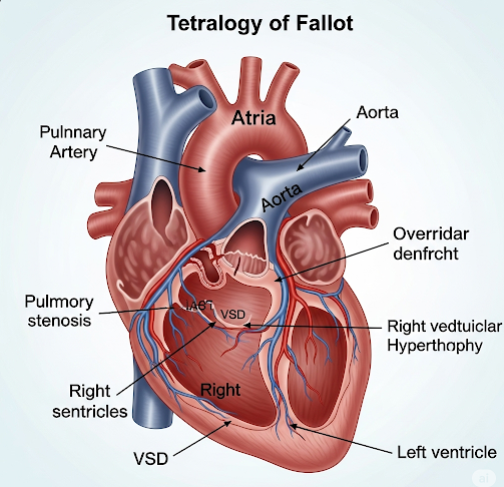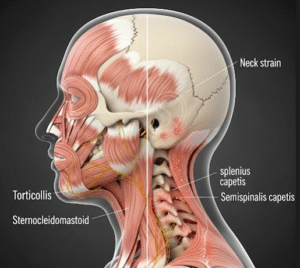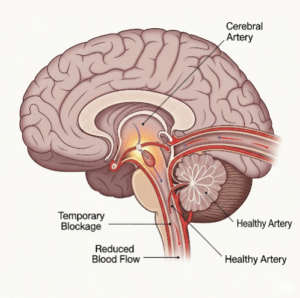Overview
Tetralogy of Fallot (TOF) is a rare congenital heart defect that involves four structural abnormalities of the heart, resulting in insufficient oxygenation of blood. These defects lead to cyanosis, commonly referred to as a “blue baby” condition, due to the reduced oxygen levels in the bloodstream. TOF is usually diagnosed at birth or in early childhood and requires timely medical intervention. South Korea offers advanced pediatric cardiology and cardiac surgery services, providing effective corrective treatments and long-term care for children born with this condition.
What is Tetralogy of Fallot?
Tetralogy of Fallot is a combination of four heart defects that affect the structure and function of the heart:
- Ventricular septal defect (VSD): A hole between the two lower chambers (ventricles) of the heart.
- Pulmonary stenosis: Narrowing of the pulmonary valve or artery, restricting blood flow to the lungs.
- Overriding aorta: The aorta is positioned over both the right and left ventricles, causing oxygen-poor blood to flow into systemic circulation.
- Right ventricular hypertrophy: Thickening of the right ventricle due to increased workload.
These defects disrupt normal blood flow, leading to low oxygen levels in the body, causing cyanosis, fatigue, and other health complications if left untreated.
Symptoms
Symptoms of Tetralogy of Fallot can vary depending on the severity of the defects and may include:
- Cyanosis (bluish skin, lips, and fingernails)
- Shortness of breath during feeding or exertion
- Poor weight gain in infants
- Fatigue and easy tiring
- Heart murmurs detected by a physician
- Clubbing of fingers or toes in chronic cases
- Episodes of fainting or “tet spells,” characterized by sudden cyanosis and difficulty breathing
Symptoms often become more noticeable in the first few months of life, and early diagnosis is critical to prevent complications.
Causes
Tetralogy of Fallot occurs due to abnormal development of the fetal heart during the first eight weeks of pregnancy. Causes may include:
- Genetic factors: Mutations or chromosomal abnormalities, such as DiGeorge syndrome, can contribute.
- Environmental factors: Maternal illnesses, infections, or exposure to toxins during pregnancy may increase risk.
- Unknown factors: In many cases, the exact cause is not identifiable.
- Family history: Having a parent or sibling with a congenital heart defect can elevate risk.
Risk Factors
Factors that increase the likelihood of Tetralogy of Fallot include:
- Maternal diabetes or obesity during pregnancy
- Maternal alcohol use or smoking
- Certain medications taken during pregnancy
- Genetic syndromes affecting heart development
- Family history of congenital heart defects
Complications
If untreated, Tetralogy of Fallot can lead to serious complications:
- Severe cyanosis and chronic low oxygen levels
- Heart failure due to increased workload on the right ventricle
- Delayed growth and development in children
- Arrhythmias (abnormal heart rhythms)
- Stroke due to formation of blood clots
- Infective endocarditis (infection of the heart lining)
- Early mortality if left uncorrected
Prevention
While congenital heart defects cannot always be prevented, certain measures can reduce risk:
- Prenatal care with regular monitoring and ultrasounds
- Managing maternal health conditions such as diabetes
- Avoiding alcohol, tobacco, and harmful medications during pregnancy
- Genetic counseling for families with a history of heart defects
- Early intervention if risk factors or abnormalities are detected
Treatment Options in Korea
Korea offers advanced treatment options for Tetralogy of Fallot, focusing on surgical correction and long-term management:
1. Surgical Treatment
- Open-heart surgery (complete repair): Corrects all four defects by closing the VSD, widening the pulmonary valve or artery, repositioning the aorta, and reducing right ventricular hypertrophy.
- Palliative surgery (shunt procedure): In severe cases, a temporary shunt may be placed to improve oxygenation before definitive repair.
2. Medications
- Used preoperatively or in cases where surgery is delayed
- Prostaglandins to maintain ductus arteriosus and improve oxygenation in newborns
- Diuretics or other heart medications to manage symptoms of heart failure
3. Postoperative Care
- Intensive monitoring in pediatric cardiac ICU immediately after surgery
- Long-term follow-up for heart function, arrhythmias, and growth
- Cardiac rehabilitation and lifestyle guidance to support overall health
- Periodic imaging and echocardiography to assess surgical outcomes
4. Cost and Hospital Care
Treatment costs in Korea vary depending on the complexity of surgery and hospitalization duration. Leading hospitals provide multidisciplinary pediatric cardiology teams, advanced cardiac imaging, and state-of-the-art operating facilities. Early surgical intervention combined with expert postoperative care significantly improves survival rates and quality of life for children with TOF.
With timely diagnosis, corrective surgery, and structured follow-up, children with Tetralogy of Fallot in Korea can achieve near-normal growth, development, and long-term cardiac function.













